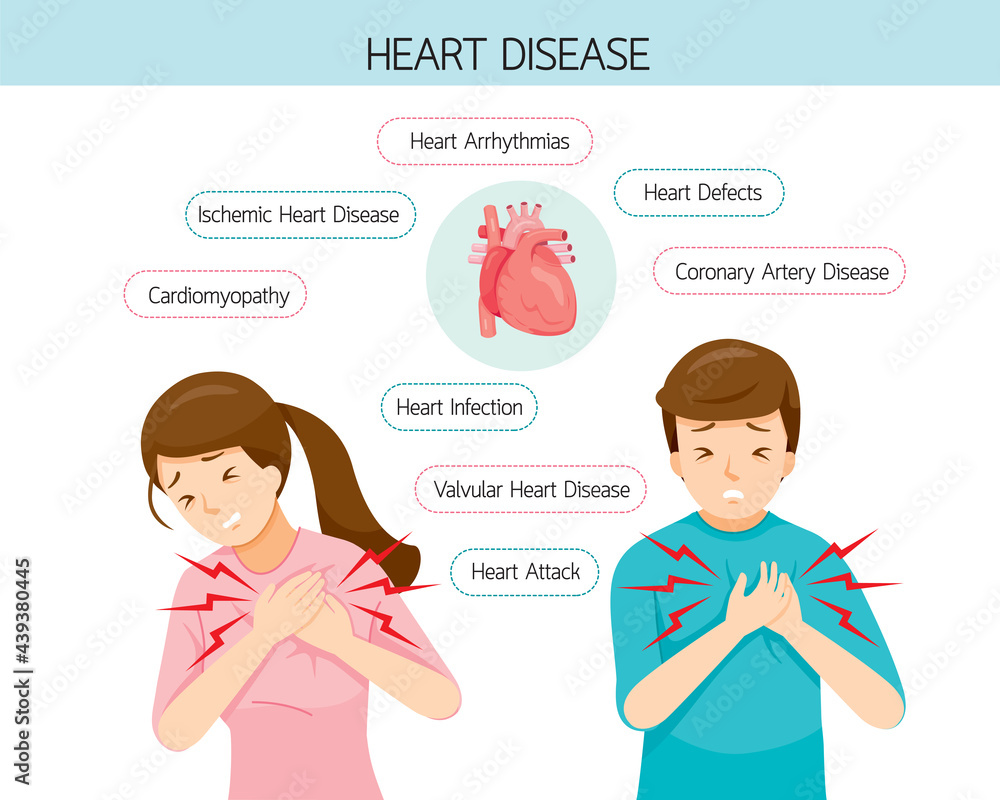As someone who has always been passionate about health and wellness, I know how important it is to understand the various types of heart disease and how to prevent and manage them. In this comprehensive article, I’ll dive deep into the world of heart disease, exploring its common types, symptoms, risk factors, diagnosis, and treatment options. By the end, I hope you’ll have a better understanding of this critical health condition and feel empowered to take control of your heart health.
Introduction to Heart Disease
Heart disease is a broad term that encompasses a range of conditions affecting the heart and its surrounding blood vessels. These conditions can range from congenital heart defects to acquired conditions like coronary artery disease, heart valve problems, and heart rhythm disorders. Understanding the different types of heart disease is crucial for recognizing the signs and symptoms and seeking appropriate medical care.
Common Types of Heart Disease

Heart disease can manifest in various forms, each with its own unique characteristics and treatment approaches. Some of the most common types of heart disease include:
- Coronary Heart Disease: This is the most prevalent form of heart disease, characterized by the buildup of plaque in the arteries that supply blood to the heart muscle.
- Ischemic Heart Disease: Also known as coronary artery disease, this condition occurs when the heart’s blood supply is reduced, often due to the narrowing or blockage of the coronary arteries.
- Congenital Heart Disease: These are heart defects that are present at birth, often caused by problems with the heart’s structure or function during fetal development.
- Heart Valve Disease: This condition involves the malfunction of one or more of the heart’s valves, which can lead to problems with blood flow.
Understanding the unique characteristics of each type of heart disease is crucial for effective prevention, diagnosis, and treatment.
Understanding Coronary Heart Disease
Coronary heart disease, also known as coronary artery disease, is the most common form of heart disease. It occurs when the major blood vessels that supply the heart with oxygen-rich blood become damaged or diseased, often due to the buildup of cholesterol-containing plaques. Over time, these plaques can narrow or completely block the arteries, reducing the heart’s ability to receive the blood and oxygen it needs to function properly.
The development of coronary heart disease is often a gradual process, with risk factors such as high blood pressure, high cholesterol, diabetes, and smoking playing a significant role. As the disease progresses, it can lead to angina (chest pain or discomfort) and, in severe cases, a heart attack.
Exploring Ischemic Heart Disease
Ischemic heart disease, or coronary artery disease, is a condition in which the heart’s blood supply is reduced, often due to the narrowing or blockage of the coronary arteries. This can result in the heart muscle not receiving enough oxygen and nutrients, leading to chest pain (angina) or a heart attack.
The primary cause of ischemic heart disease is the buildup of plaque, a fatty substance, in the coronary arteries. Over time, this plaque can harden and narrow the arteries, restricting blood flow to the heart. Factors such as high cholesterol, high blood pressure, diabetes, and smoking can increase the risk of developing ischemic heart disease.
Symptoms of ischemic heart disease may include chest pain or discomfort, shortness of breath, fatigue, and nausea. In the event of a heart attack, symptoms may include severe chest pain, difficulty breathing, and a sense of impending doom.
Read More:
Understanding Your Pulse: A Guide to Target Heart Rates for Optimal Fitness
What is Congenital Heart Disease?
Congenital heart disease refers to a range of heart defects that are present at birth. These defects can occur during the early stages of fetal development and can affect the structure or function of the heart. Some common types of congenital heart disease include:
- Atrial Septal Defect (ASD): A hole in the wall (septum) between the heart’s two upper chambers (atria).
- Ventricular Septal Defect (VSD): A hole in the wall (septum) between the heart’s two lower chambers (ventricles).
- Tetralogy of Fallot: A combination of four heart defects that affect the structure and function of the heart.
- Transposition of the Great Arteries: A condition where the two main arteries leaving the heart (the aorta and the pulmonary artery) are switched.
Congenital heart defects can range from mild to severe, and their symptoms and treatment options vary depending on the specific condition. Some defects may be detected during pregnancy, while others may not be diagnosed until later in life.
Symptoms and Risk Factors of Heart Disease
The symptoms of heart disease can vary depending on the type and severity of the condition. However, some common symptoms include:
- Chest pain or discomfort
- Shortness of breath
- Fatigue
- Irregular heartbeat
- Swelling in the legs, ankles, and feet
Risk factors for heart disease can include:
- High blood pressure
- High cholesterol
- Diabetes
- Obesity
- Smoking
- Sedentary lifestyle
- Family history of heart disease
- Stress and anxiety
Recognizing these symptoms and risk factors is crucial for seeking timely medical attention and taking steps to prevent or manage heart disease.
Diagnosing Heart Disease
Diagnosing heart disease typically involves a combination of medical history, physical examination, and various diagnostic tests. Some common diagnostic tools used to assess heart health include:
- Electrocardiogram (ECG or EKG): This test measures the electrical activity of the heart and can help identify abnormalities in heart rhythm or damage to the heart muscle.
- Echocardiogram: This imaging test uses sound waves to create a detailed picture of the heart’s structure and function, allowing healthcare providers to assess the pumping ability and valves of the heart.
- Stress Test: This test measures the heart’s response to physical activity, either through exercise or the use of medication, to identify any problems with blood flow to the heart.
- Cardiac Catheterization: This invasive procedure involves inserting a thin, flexible tube (catheter) into a blood vessel in the arm or groin and guiding it to the heart to assess the condition of the coronary arteries.
Depending on the individual’s symptoms and risk factors, healthcare providers may recommend additional tests to obtain a comprehensive understanding of the patient’s heart health and develop an appropriate treatment plan.
Treatment Options for Heart Valve Disease
Heart valve disease, which involves the malfunction of one or more of the heart’s valves, can be a serious condition that requires prompt medical attention. Treatment options for heart valve disease may include:
- Medication: In some cases, medications can be used to manage the symptoms of heart valve disease, such as diuretics to reduce fluid buildup or anticoagulants to prevent blood clots.
- Surgical Repair or Replacement: For more severe cases, surgery may be necessary to repair or replace the damaged heart valve. This can involve minimally invasive procedures or open-heart surgery.
- Transcatheter Valve Procedures: These less-invasive procedures use a catheter to access the heart and repair or replace the damaged valve without the need for open-heart surgery.
The specific treatment approach will depend on the type and severity of the heart valve disease, as well as the individual’s overall health and medical history. It’s essential to work closely with a healthcare provider to develop a personalized treatment plan.
Lifestyle Changes to Prevent Heart Disease
While some risk factors for heart disease, such as genetics, cannot be controlled, there are many lifestyle changes that can help reduce the risk of developing or worsening heart disease. These include:
- Maintaining a Healthy Diet: Eating a diet rich in fruits, vegetables, whole grains, lean proteins, and healthy fats can help lower cholesterol, blood pressure, and inflammation, all of which are risk factors for heart disease.
- Regular Physical Activity: Engaging in regular physical activity, such as brisk walking, swimming, or cycling, can improve heart health by strengthening the heart muscle, reducing blood pressure, and promoting healthy weight management.
- Quitting Smoking: Smoking is a major risk factor for heart disease, and quitting can significantly reduce the risk of developing heart-related complications.
- Stress Management: Finding healthy ways to manage stress, such as through meditation, yoga, or counseling, can help lower blood pressure and inflammation, which are linked to heart disease.
- Maintaining a Healthy Weight: Achieving and maintaining a healthy body weight through a balanced diet and regular exercise can help reduce the risk of heart disease and related conditions like high blood pressure and type 2 diabetes.
Making these lifestyle changes can have a profound impact on your heart health and overall well-being.
Conclusion: Taking Control of Your Heart Health
Heart disease is a complex and multifaceted condition that affects millions of people worldwide. By understanding the different types of heart disease, recognizing the symptoms and risk factors, and taking proactive steps to maintain a healthy lifestyle, you can significantly reduce your risk and take control of your heart health. If you have any concerns about your heart health or want to learn more about how to prevent and manage heart disease, I encourage you to schedule an appointment with a healthcare provider. They can provide personalized guidance and develop a comprehensive plan to support your heart health journey.
Remember, your heart is the foundation of your overall well-being, and taking care of it today can lead to a healthier, more fulfilling tomorrow. Let’s work together to ensure your heart is strong and resilient for years to come.

